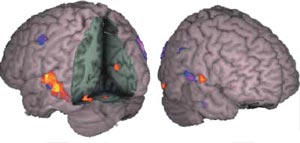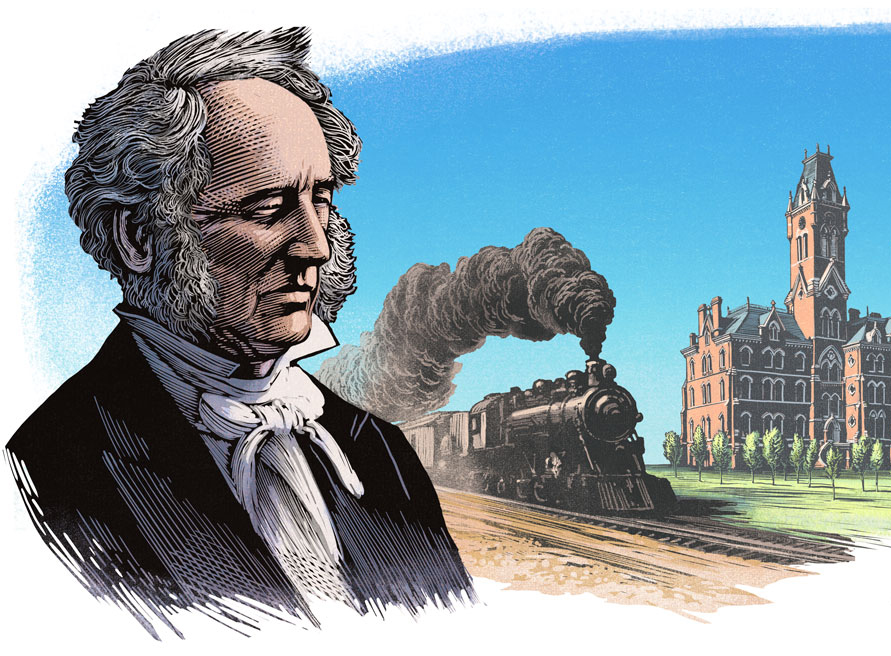
Innovative developmental cognitive neuroscientist Bruce McCandliss, winner of a presidential early career award and principal investigator for several National Institutes of Health grants, has joined Peabody College to continue his research into educational neuroscience, the study of how a child’s brain might influence educational experience and how educational experiences might influence a child’s brain.
McCandliss joined the Peabody College faculty as Patricia and Rodes Hart Professor of Psychology and Human Development earlier this year. His specific research focus—looking at how brain mechanisms influence performance and how teaching drives changes in the brain—may have a profound impact on how children, especially struggling learners, are taught.
His appointment complements Peabody’s existing strengths in combining teaching and learning theory with scientific research. “Peabody faculty members have long worked at the forefront of developmental science,” says Camilla Benbow, Patricia and Rodes Hart Dean of Education and Human Development. “As researchers increasingly rely on new tools and technologies to advance our understanding about how humans grow and learn, the addition of Bruce McCandliss to our ranks will ensure that Peabody continues to make valuable contributions to the knowledge base. We are delighted to have him with us.”
I’m interested in how individual differences in brain structure impact learning in particular domains, like reading or mathematics.
McCandliss, 43, holds a doctorate in psychology with a special emphasis on cognitive neuroscience. He has also obtained advanced post-doctoral training in the use of functional magnetic resonance imaging (fMRI) to examine brain activity underlying reading and language development in children. He comes to Vanderbilt from the Weill Medical College of Cornell University, where he was one of the founding faculty members of the Sackler Institute for Developmental Psychobiology. For the last decade, he has focused on how children’s brains activate when working on specific tasks, how their brain structures influence their learning and how teaching methods can alter brain function.
As a developmental cognitive neuroscientist, McCandliss focuses his research on how brain development and cognitive development relate to each other. He uses fMRI and diffusion tensor imaging in his research, brain-imaging tools that tell him how individual differences in brain structure impact learning in particular domains, like reading or mathematics.
“Vanderbilt is the ideal place to do this research because here I am at Peabody, the best school of education in the United States, and the Vanderbilt University Institute of Imaging Science—this amazing place with state-of-the-art imaging science and faculty—is right across the street,” he says. “It’s the ideal opportunity to bring together research on education and neuroscience.”
McCandliss has applied a scientific approach to measuring mental ability since his early years as an undergraduate honors student in the late 1980s. “I’m interested in how individual differences in brain structure impact learning in particular domains, like reading or mathematics,” he says. “We must keep in mind that it was only 5,000 years ago that humans started connecting language to letters, and this transformed our world as well as our minds.
 “Creating new abilities such as reading and mathematics in a child’s mind and brain via education may be one of the most fundamental enhancements of intellectual activity and capacity and has a profound impact on how the brain organizes language and thought. We are now able to study this by combining social science (psychology and education) with natural science (biology and physics that enable brain imaging). Together these create a new field of educational neuroscience.”
“Creating new abilities such as reading and mathematics in a child’s mind and brain via education may be one of the most fundamental enhancements of intellectual activity and capacity and has a profound impact on how the brain organizes language and thought. We are now able to study this by combining social science (psychology and education) with natural science (biology and physics that enable brain imaging). Together these create a new field of educational neuroscience.”
His work was recognized in 2006 when he received the Presidential Early Career Award for Scientists and Engineers (PECASE), the highest honor given by the U.S. government to outstanding researchers in the early part of their independent careers. The award recognized McCandliss’s research into the biological basis for language development, developmental disorders such as dyslexia, and his approach to using insights of cognitive neuroscience, including brain imaging, to help develop methods to alleviate reading disabilities.
His research shows that tailored educational techniques can improve reading skills in children, and his laboratory research with adults shows how different teaching strategies can lead to different patterns in brain activity. He collaborated with educational researchers to co-develop a software program called Reading Works that helped struggling young readers in Pittsburgh and New York City inner-city public schools jump more than a grade level in reading ability in just a few months. His more recent work has begun to unravel how we can understand the remarkable differences that exist in how easily children learn to read through understanding the differences in how children’s brains are wired.
By using MRI scans to measure “white matter tracts”—the large masses of fibers that connect one part of the brain to another—he is able to relate anatomical differences that exist in specific brain structures to differences in how well children progress through the task of learning to read. His future research directly examines a question he is quite excited to learn the answer to: How does the process of educating the brain, via schooling activities, change the structure of the brain?
In addition to the PECASE project, McCandliss brings to Vanderbilt several million dollars in federally funded research projects from NIH, as well as a recently awarded $1 million NSF study into how first-graders learn math.
“My most recent project is looking at brain-based research focused on understanding how children differ in math-related skills before school entry and how these skills change as the results of schooling activities,” he said. “The three-year study will focus on first graders and how they learn math during this critical year.”
Why first graders? Because first grade is a year of incredible growth in students’ classroom engagement in reading, math skills and writing. McCandliss is in the process of working with Nashville-area schools to recruit students for the study.

The main question in the grant is: How do individual differences in children’s brain mechanisms for number abilities relate to gains in learning first-grade mathematics, and how might first-grade instruction drive changes in such brain mechanisms? It’s the duality of that question that interests McCandliss.
“I want to look at how the process of learning and using symbols such as numbers and letters changes the white matter tracts in their brains and to explore how brain activity reorganizes over the course of learning,” he says. “Children are so incredibly variable, both in terms of how quickly they come to master educational material such as math and reading and in their brain structures. My new research will try to measure these differences at the beginning and end of the school year to predict outcomes and also capture the impact of learning experiences on brain structures.
“Are we talking about a future in which every single child gets a brain scan?” he continues. “No, of course not. We hope to use this research to gain basic insights into principles of learning and what encourages learning, and hopefully we can apply those insights to enhance education to help all children develop skills in these key areas of mathematics and reading and help them perform these key skills even better.”
The overall goal of McCandliss’ research is to understand how reading and math skills develop and also how children develop the ability to pay attention so that they can learn.
“I have three overall goals in trying to bring together research on education and neuroscience,” McCandliss says. “The first is to understand the development of reading skills from the basics to full content comprehension. Second, I want to study how we learn math, which is a culturally developed system to understand numbers, space and time. How does learning this system lead to changes in specific brain structures and expand our mental abilities? We don’t really know that yet.
“Third, I want to learn about children’s general attention skills and how these play out in learning and education. We need to understand attention as a basic cognitive skill that differs from child to child, and is engaged differently by different educational approaches and activities. Attention is the gateway to learning, as generally, we learn most effectively those things that we pay attention to.”
Across each of these domains, a key aspect of this research is understanding why children differ and for McCandliss, educational neuroscience gets at the heart of this question by bringing natural science observations of brain mechanisms into the mix.
“We’re starting to learn how children differ within particular educational domains, such as reading and mathematics, and how such differences may be linked to variation in brain structures and patterns of brain activation,” he says. “The chance to explore these topics in children as they progress through education is a really exciting opportunity, and a really exciting time in science.
“The hope here is that we will be able to adapt our educational approaches to these new insights about the individual needs of students. For example, for a struggling reader who is having problems decoding and mapping words, we can use brain imaging to help answer the question, ‘Why do they struggle?’ And in answering this question we can focus new research on strategies to help them overcome that struggle.”

